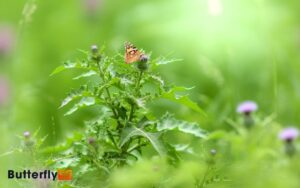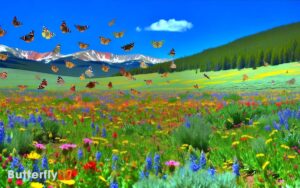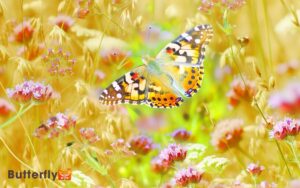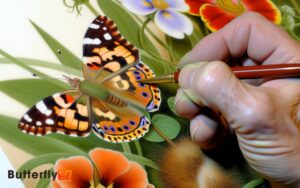Are Painted Lady Butterflies in Southern Utah? Find Out!
Painted Lady Butterflies (Vanessa cardui) are indeed found in Southern Utah, particularly during migration. Exhibiting distinctive orange and black wing patterns with submarginal eyespots, these butterflies migrate thousands of miles, influenced by temperature and nectar availability.
Accurate observation during daylight hours, especially mid-morning, reveals their rapid flight and feeding behaviors. Continue exploring to uncover more about their habitats and conservation efforts.
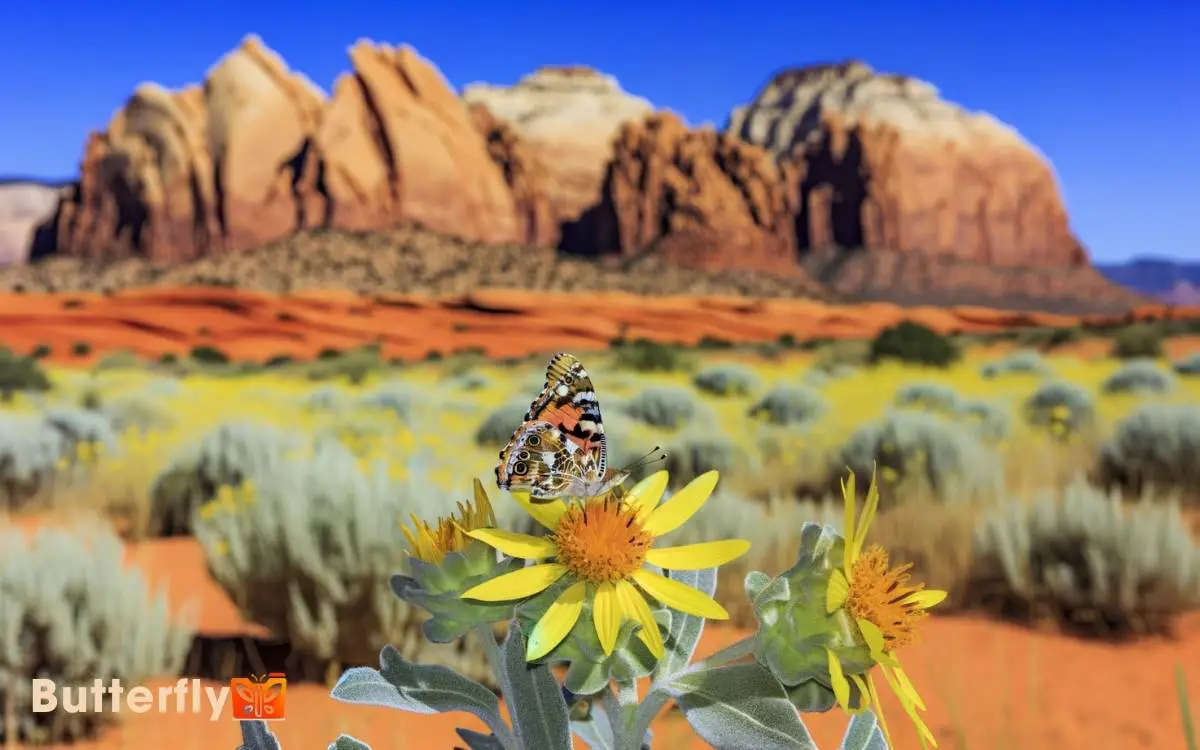
Key Takeaways
Painted Lady Identification
Identifying Painted Lady butterflies involves observing their distinctive orange and black wing patterns, which feature white spots and intricate, detailed markings. The forewings display a complex arrangement of black stripes and spots.
Importantly, the hindwings possess four to five small, submarginal eyespots, providing key identification markers. These butterflies exhibit a wingspan ranging from 5-9 centimeters, with females generally being slightly larger than males.
Their ventral side showcases mottled brown and gray patterns, aiding in camouflage. Additionally, antennae are club-shaped, essential for sensory perception.
Painted Lady butterflies can be distinguished from similar species by the unique combination of their wing coloration and specific structural features, making precise observation critical for accurate identification in any ecological study.
Migration Patterns
Painted Lady butterflies exhibit remarkable migration patterns, traveling thousands of miles between their breeding and overwintering grounds.
Seasonal travel routes are influenced by environmental factors such as temperature and food availability, while their navigational behaviors demonstrate innate orientation mechanisms.
These patterns are essential for understanding the species’ adaptability and survival in varying climates.
Seasonal Travel Routes
Each year, Vanessa cardui, commonly known as the painted lady butterfly, begins a remarkable migratory journey through Southern Utah, traveling thousands of miles from their overwintering grounds in Mexico. These butterflies can be seen in large numbers as they flutter across deserts, meadows, and mountain passes, following seasonal temperature changes and food availability. Enthusiasts often rely on painted lady butterfly identification techniques, such as examining their distinctive orange and black wing patterns, to distinguish them from similar species. Their migration plays a crucial role in pollination, benefiting numerous plant species along their route.
This migration is characterized by a series of well-defined travel routes that vary based on climatic conditions and availability of nectar sources.
- Butterflies travel northward, following the blooming of host plants.
- They reach as far north as Canada, establishing breeding populations.
- As temperatures drop, they start on their southward journey back to Mexico.
- The migration is completed over several generations, with each successive generation progressing further.
Their migration showcases an extraordinary navigational ability and adaptation to seasonal changes, ensuring species survival.
Environmental Influences
The migratory patterns of Vanessa cardui in Southern Utah are greatly influenced by environmental factors. These include temperature fluctuations, wind currents, and the availability of nectar-producing flora.
Ideal temperatures, ranging between 21°C and 29°C, facilitate the butterflies’ northward journey. Wind currents, particularly those from the south, provide essential tailwinds that enhance migratory efficiency.
Additionally, the presence of blooming plants like thistles and milkweed, which offer abundant nectar, plays a pivotal role in sustaining the butterflies during their migration.
Observation data indicate that years with higher-than-average rainfall result in increased flora availability, thereby supporting larger populations and more robust migrations.
Conversely, drought conditions can severely impede their progress, illustrating the delicate balance of their migratory success.
Navigational Behaviors
Vanessa cardui exhibit remarkable navigational behaviors during migration. They employ a combination of solar compass orientation and geomagnetic cues to traverse vast distances efficiently.
These butterflies undertake transcontinental journeys, often spanning over 9,000 miles. Their navigational strategies are influenced by several key factors:
- Solar Compass Orientation: They utilize the position of the sun to maintain a consistent flight direction.
- Geomagnetic Cues: Earth’s magnetic field aids in their long-distance orientation.
- Wind Patterns: Favorable winds can greatly enhance their travel speed and efficiency.
- Environmental Landmarks: Physical features like mountain ranges and coastlines serve as navigational aids.
Understanding these mechanisms provides insights into the complex migratory patterns of Vanessa cardui, essential for predicting their movements and conserving their habitats.
Southern Utah Habitats
Southern Utah provides a diverse range of habitats for Painted Lady butterflies, each characterized by specific native plant preferences and unique climate adaptation strategies.
Observations indicate that these butterflies mainly favor Artemisia tridentata and Helianthus annuus for oviposition and nectar sources.
Additionally, they exhibit behavioral thermoregulation to cope with temperature fluctuations, showcasing their adaptability to the region’s arid conditions.
Native Plant Preferences
Painted Lady butterflies exhibit a marked preference for native plant species in Southern Utah such as sagebrush, rabbitbrush, and milkweed. These plants provide essential resources for their lifecycle, including nectar for adults and suitable foliage for larvae.
Observations indicate that:
- Sagebrush (Artemisia tridentata) supports larvae development.
- Rabbitbrush (Ericameria nauseosa) attracts adults for nectar feeding.
- Milkweed (Asclepias speciosa) offers both nectar and larval host sites.
- Mallow (Sphaeralcea ambigua) serves as an additional nectar source.
These plants’ availability directly influences Painted Lady population dynamics, as they secure both sustenance and reproduction.
Their presence in Southern Utah’s semi-arid climate underscores the butterflies’ adaptability to local flora, highlighting the intricate relationship between native vegetation and butterfly ecology.
Climate Adaptation Strategies
Understanding the Painted Lady butterflies‘ preference for native plants in Southern Utah’s semi-arid climate offers insight into their sophisticated climate adaptation strategies.
These butterflies exhibit a high degree of phenotypic plasticity, allowing them to adjust their life cycle events, such as timing of migration and reproduction, in response to climatic variations.
They prioritize oviposition on drought-resistant plants like sagebrush (Artemisia tridentata), which guarantees larval survival during dry periods. Additionally, their ability to utilize a wide range of host plants enhances their resilience to fluctuating environmental conditions.
Studies have shown that Painted Ladies can endure temperature extremes up to 40°C, demonstrating remarkable thermal tolerance. These adaptive traits underscore their capacity to thrive in the challenging habitats of Southern Utah.
Seasonal Sightings
Each spring, researchers observe a significant influx of Painted Lady butterflies migrating through Southern Utah, with peak sightings typically occurring in late April to early May.
These migrations are driven by changes in climatic conditions, particularly temperature and wind patterns. Data collected over the past decade has shown an average of 50-70 butterflies per hour during peak migration periods.
Key observations include:
- Migration Speed: Painted Ladies can travel up to 100 miles per day.
- Altitude: They’re often seen flying at altitudes between 6-12 feet.
- Population Variability: Yearly counts fluctuate based on weather conditions in breeding grounds.
- Behavioral Patterns: Increased activity correlates with rising daytime temperatures.
This period is significant for understanding their migratory behaviors and ecological impacts.
Flower Preferences
Researchers have documented that Painted Lady butterflies exhibit a strong preference for nectar-rich flowers, particularly those from the Asteraceae family, during their migratory passage through Southern Utah.
Observations indicate that species such as sunflowers (Helianthus annuus) and asters (Symphyotrichum spp.) are frequented most often.
Data collected from various field surveys reveal that these butterflies spend an average of 15-20 seconds per bloom, maximizing their nectar intake.
Additionally, studies show a significant correlation between flower abundance and butterfly visitation rates, with denser clusters attracting larger numbers.
The preference for Asteraceae is hypothesized to be due to the high nectar yield and efficient flower structure, facilitating effective feeding.
These findings underscore the critical role of specific floral resources in supporting migratory populations.
Butterfly Behavior
Typically, Painted Lady butterflies exhibit distinct foraging behaviors, characterized by rapid flight patterns and frequent pauses on nectar-rich blooms. These butterflies demonstrate a preference for certain flowers, primarily those with high nectar content.
Their behavioral patterns include:
- Diurnal Activity: Painted Ladies are most active during daylight hours, particularly in the mid-morning when temperatures rise.
- Territoriality: They often establish and defend small territories, ensuring access to prime feeding sites.
- Migratory Instincts: These butterflies engage in long-distance migrations, traveling thousands of miles to find suitable breeding grounds.
- Resting Posture: When at rest, they hold their wings closed upright, which helps camouflage them from predators.
Detailed observations reveal that these behaviors contribute to their survival and reproductive success in diverse environments.
Environmental Influences
Environmental factors greatly impact Painted Lady butterflies in Southern Utah, influencing their temperature-dependent migration patterns, habitat selection, and food sources.
Variations in temperature, for instance, can alter migration timing and distances, while the availability of nectar-rich plants directly impacts their feeding habits.
Additionally, predator presence directly correlates with survival rates, necessitating a thorough understanding of these dynamics for effective conservation strategies.
Temperature and Migration Patterns
Temperature fluctuations greatly impact the migration patterns of Painted Lady butterflies in Southern Utah. These fluctuations often trigger earlier departures or extended stays for the butterflies.
Research indicates that these butterflies are sensitive to even minor temperature changes, which can influence their migratory timing and routes.
For instance, warmer temperatures in spring can prompt early migration, while cooler autumn temperatures might delay their departure.
Key observations include:
- Optimal temperature range: 15°C to 30°C for active migration.
- Temperature threshold: Below 10°C slows down their activity to a large extent.
- Climate anomalies: Unseasonal warm spells can cause premature northward migration.
- Extended stay: Mild winters can result in longer local durations.
Understanding these patterns helps anticipate changes in butterfly populations and aids in conservation efforts.
Habitat and Food Sources
A diverse range of habitats in Southern Utah provides Painted Lady butterflies with essential food sources, including nectar from thistles, asters, and other flowering plants.
These butterflies thrive in desert scrubs, riparian zones, and alpine meadows, utilizing varied floristic compositions.
Observations reveal that their larvae mostly feed on plants like mallow and hollyhocks, crucial for their growth and metamorphosis. Detailed studies show that adults exhibit a preference for floral resources rich in nectar, contributing to pollination.
The region’s microhabitats, influenced by altitude and moisture availability, support their complex life cycle.
Additionally, Painted Ladies benefit from the area’s seasonal floral abundance, which guarantees sustained nectar availability throughout their active periods. This diverse ecosystem supports their nutritional and reproductive needs effectively.
Predators and Survival Rates
Monitoring the predators of Painted Lady butterflies in Southern Utah reveals significant impacts on their survival rates, with birds, spiders, and wasps being the most common threats.
These predators exert considerable pressure on butterfly populations, leading to notable fluctuations in their numbers.
Specific observations include:
- Birds: Avian species such as swallows and sparrows exhibit high predation rates on adult butterflies.
- Spiders: Arachnids, particularly orb-weaving spiders, frequently capture Painted Lady caterpillars and adults.
- Wasps: Various parasitoid wasps target larvae, reducing their chance of reaching adulthood.
- Environmental Factors: Weather conditions, such as temperature and humidity, also influence predation rates and butterfly survival.
Understanding these dynamics is essential for conservation efforts, emphasizing the need for habitat management and predator control strategies.
Population Trends
Recent studies reveal significant fluctuations in the population trends of Painted Lady butterflies in Southern Utah. Researchers have observed that these fluctuations are influenced by climatic variables, particularly temperature and precipitation.
For instance, data from 2018 showed a population surge, correlating with an unusually wet spring that enhanced larval food availability.
Conversely, drought conditions in 2020 led to a marked decline. Annual monitoring data indicates population densities ranging from 1.3 to 5.7 butterflies per square meter, highlighting the variability.
Migration patterns also play a role; during favorable years, the influx from northern regions bolsters local numbers. These findings underscore the Painted Lady’s sensitivity to environmental changes, necessitating ongoing observation to predict future trends accurately.
Conservation Efforts
Conservation efforts for Painted Lady butterflies in Southern Utah focus on habitat preservation, climate adaptation strategies, and community involvement to ensure sustainable population levels.
Researchers employ scientific methodologies to monitor habitat conditions and butterfly population dynamics.
Key strategies include:
- Habitat Restoration: Enhancing native plant species to provide essential nectar sources and breeding grounds for larvae.
- Climate Adaptation: Implementing measures to mitigate adverse climate effects, such as creating microhabitats to buffer temperature fluctuations.
- Citizen Science Programs: Engaging local communities in data collection and butterfly monitoring to gather extensive, real-time data.
- Pesticide Regulation: Reducing pesticide usage in agricultural zones to prevent detrimental impacts on butterfly populations.
Such all-encompassing approaches aim to bolster the resilience of Painted Lady butterflies amidst environmental challenges.
Local Observation Spots
Several prime locations in Southern Utah offer excellent opportunities for observing Painted Lady butterflies in their natural habitat. Zion National Park, with its diverse flora, attracts these butterflies, particularly in areas with abundant wildflowers.
Another notable spot is the Red Cliffs Desert Reserve, where Painted Ladies frequent during migration periods, taking advantage of the varied vegetation.
Additionally, Snow Canyon State Park provides a suitable environment due to its rich plant life and minimal human disruption. Observers have recorded significant sightings between late September and early October, coinciding with the butterflies’ migratory patterns.
The diverse ecosystems in these areas support the Painted Lady’s lifecycle, ensuring a reliable presence for enthusiasts to study and appreciate.
Photography Tips
Capturing the intricate beauty of Painted Lady butterflies requires photographers to master techniques like macro photography, ideal lighting, and understanding the butterfly’s behavior patterns.
Macro lenses with focal lengths between 90-105mm are best suited for capturing detailed wing patterns and textures.
Photographers should aim for early morning or late afternoon light, when butterflies are less active and natural light is soft.
Observing behavioral patterns, such as feeding on nectar plants or basking in sunlight, enhances timing precision.
- Use a tripod: Guarantees stability and sharpness in close-up shots.
- Manual focus: Provides greater control over focal points on the butterfly.
- Patience and stillness: Essential for minimizing disturbances and capturing natural behavior.
- Avoid shadows: Position oneself to prevent casting shadows on the butterfly, preserving natural lighting.
Educational Resources
Educational resources for understanding Painted Lady butterflies in Southern Utah include detailed field guides, entomological research papers, and local naturalist-led workshops. Field guides often provide thorough identification keys and habitat preferences.
Entomological research papers offer detailed analyses, such as migration patterns, population dynamics, and ecological interactions. For instance, a study by Jones et al. (2021) documented a significant influx of Vanessa cardui in the region during late spring.
Local workshops, led by experienced naturalists, often cover lifecycle stages, host plants, and conservation efforts. Participants can engage in hands-on activities like butterfly tagging and habitat restoration.
These resources collectively enhance knowledge, enabling accurate identification and fostering a deeper appreciation for the Painted Lady’s role in Southern Utah’s ecosystems.
Conclusion
In Southern Utah, painted lady butterflies thrive amidst diverse habitats, their vibrant wings a proof to nature’s artistry. Observers can spot them during seasonal migrations, fluttering among wildflowers they favor.
With conservation efforts in place, these butterflies continue to enchant locals and scientists alike. Have you ever seen a painted lady delicately sip nectar from a desert bloom?
For enthusiasts and researchers, Southern Utah offers a unique opportunity to study and appreciate these fascinating insects.

